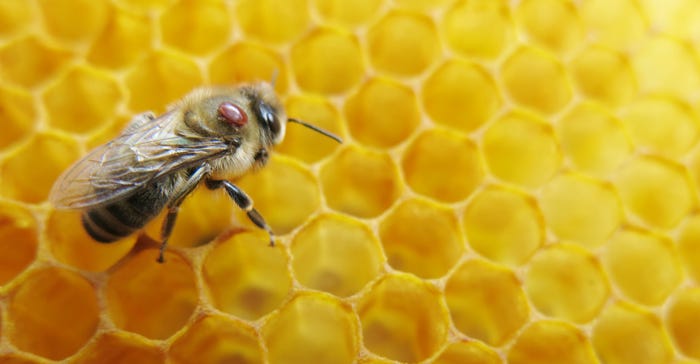November 10, 2021

The news these days has been filled with talk about RNA technology. This genetic tool can be used — in a highly targeted way — to accomplish several tasks from the COVID-19 vaccine to control of Colorado potato beetle. A Boston-based startup, GreenLight Biosciences, has mastered the manufacture of RNA in quantity, and it's creating new ways to control a range of crop profit-robbers.
"Welcome to the world of RNA," says Mark Singleton with GreenLight. "I first heard about RNA 30 years ago, and I was smitten. I liked the promise."
Singleton, who is senior vice president of technology and external innovation at GreenLight, wasn't working with RNA at the time, yet he was intrigued. But there are challenges to using such a targeted tool: from manufacturing "bare" RNA that's designed to do a specific job, to figuring out how to get the product on target in a way that it will do the job. Remember, the RNA must be “injected” in some way into the insect — or disease or weed — to work. And if eating the product breaks down the RNA before it can do the job, it has little value.
 TOUGH ON BEES: The varroa destructor mite has hit beekeepers across the country. A new approach using RNA and an interesting delivery method offers promise for greater control.
TOUGH ON BEES: The varroa destructor mite has hit beekeepers across the country. A new approach using RNA and an interesting delivery method offers promise for greater control.

GreenLight is overcoming all those issues and has demonstrated effectiveness in field trials in control of botrytis, a crop disease that causes food to rot. "That was proof of concept, and we just mixed it with water and sprayed it on the disease," Singleton recalls. "Those experiments were done with naked double-stranded RNA; there was no special technology, just water." The result was solid control of the disease and the first use of RNA for controlling botrytis.
Beating more complex pests
GreenLight has seven products in development it believes will be cleared for use by 2026. The first two are targeted at a couple of pests — the first is Colorado potato beetle, which can range far and wide causing plenty of damage to potatoes — and not just in Colorado.
Singleton explains that GreenLight identified double-stranded RNA targeted to a process in the CPB that stopped the bug from eating. The product works, but for GreenLight to succeed the product also has to fit a farmer's practices. In tests, the company shows farmers how the product works.
"We sprayed the product onto the crop; it's a simple formulation," Singleton says. "So, the farmer got to look at the bottle. He's going to love the formulation because it's easy to handle. You can mix it in anything, and it goes into his sprayer. You can put it in with your chemistry. There are no special instructions."
The beetle consumes the product from the leaf, and because it has no simple approach to breaking down the RNA in the gut, it passes into the insect and stops a key physical process: ending the bug. Being so targeted, the product has demonstrated no adverse impacts on beneficial insects in the environment.
Singleton notes that CPB usually appears at about the same time during the season, so a single spray can bring control in many situations. The company is working on carrier formulations that would keep the RNA on the plant longer, or using other formulations that might enter the bug directly rather than waiting to be consumed.
Once the proper RNA is identified, it's that delivery mechanism that makes a difference, and GreenLight is investing a lot of capital in exploring the many ways to do the job.
Stopping varroa mites early
In honeybees, the process to get RNA dispersed in a form that will stop the varroa destructor mite brings new ideas to application.
The varroa destructor mite has become the bane of the honeybee industry. Linked to colony collapse disorder and other challenges that hit hives, the mite latches itself onto the bee, consuming energy from the animal — but also bringing other diseases.
Controlling the varroa mite is a challenge — because of the size of the bees, and also because the insecticides that might stop the mite could hurt the bee. There are targeted insecticides at work on the market, but GreenLight is building on some intellectual property acquired from Bayer to innovate controls.
The company has identified an RNA that will stop varroa mites. But how to deliver it? While the final approach is still under development, the company's approach takes a different turn than what's currently on the market.
"That mite is like a fist-sized lump on your chest, connected and injecting disease," Singleton says. "Current controls work with that adult mite on the bee, which means the bee may already infected with a disease."
The GreenLight approach gets to varroa mites very early; in fact, in the brood cell with the larvae before they hatch. "We can feed the RNA for controlling varroa mites into bees using sugar water," Singleton says. "The bee uses that material to create brood food for that hive cell, and the RNA is there."
The RNA present stops the varroa mite before it can attach itself to the bee, boosting hive health and preventing disease spread. The varroa mite product will be next on the list for regulatory review, after the CPB product's review.
Faster to market
Singleton remembers the days when getting the genome of a plant or animal was a costly chore. Today, genome information is readily available for a wide range of crop pests and diseases. The key is to identify the RNA mechanism that will work against the pest.
He adds that identifying just the right RNA tool means finding the one that works on the target but has no impact on off-target pests, like beneficial insects.
While insects and diseases are a key target for RNA, there are other potential uses for the technology, but that will take time. Singleton does note that the targeted nature of this technology has been positively received by regulators. "We're not just a CPB company — with fingers crossed, EPA will give us approval early next year. … The speed with which we're able to go from an idea to a product that works is very, very quick," he says. "We're treated as a biological, [EPA] classed RNA as a biomolecule, and it is a food product."
He explains that the way the product behaves — it disappears in the environment and leaves no residues in the soil or water — makes the regulator's job very easy.
About the Author(s)
You May Also Like






